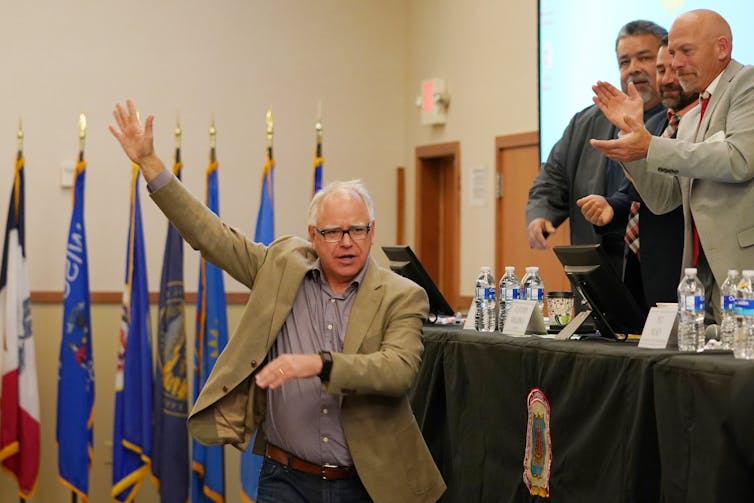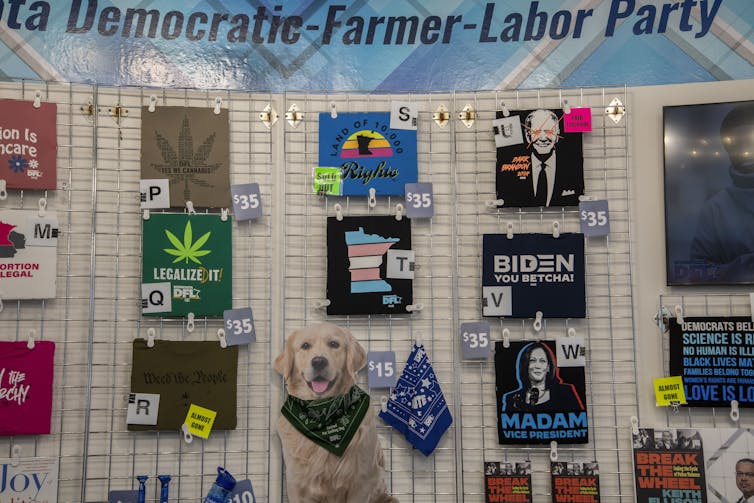Who is Tim Walz? Understanding the Minnesota Democratic-Farmer-Labor Party can help make sense of th
Walz, who is set to debate JD Vance on Oct. 1, comes from a particular kind of progressive politics in the Midwest, united under the Minnesota Democratic-Farmer-Labor Party.

Since Democratic presidential nominee Kamala Harris selected Tim Walz as her running mate in August 2024, political commentators have offered various takes on Walz – is he pragmatic or progressive, centrist or radical, a grassroots lefty or a mainstream Democrat?
Walz will have a chance to speak directly to voters and possibly explain who he is and what he stands for when he debates Republican contender JD Vance on Oct. 1, 2024.
I am a scholar of populist politics in North America, and I understand why it is difficult to define how Walz fits within the Democratic Party.
On the one hand, Walz is a shock to the Democratic Party, which often endorses elite-educated, moderate politicians from the country’s two coasts. Walz is a former public school teacher who graduated from a state college in Nebraska – and he is not afraid to embrace the moniker of a “progressive,” which some Democrats reject in order to avoid false comparisons to socialists.
As Walz said in an August 2024 donor call for Harris: “Don’t ever shy away from our progressive values. One person’s socialism is another person’s neighborliness.”
Yet, Walz is unlike many other progressives in the Democratic Party. He is a gun owner and a hunter – and was one of the “best shots in Congress” when he represented Minnesota in Washington, as he will remind people. He uses sports metaphors to convey his messages, rallying Democrats behind a “fourth quarter” comeback in the election, for example.
Yet these apparent contradictions make sense when considering that Walz follows a rich lineage of Midwestern progressive politics that starts with the Minnesota Democratic Farmer-Labor Party, a state affiliate of the Democratic Party that maintains the traditions and values of populist farmer politics in the American Midwest.

Farmer-Labor’s Midwestern roots
The Minnesota Democratic-Farmer-Labor Party is one of the first major recognized political parties in the state. It began more than 100 years ago as a form of populist protest to the harm industrialization and urbanization brought to rural farmers at the turn of the 20th century.
In the late 1800s, political movements like the Grangers and the Farmers’ Alliances organized to bring attention to falling crop prices, increases in railroad fees for transporting crops and the monopolization of agribusiness.
In Minnesota, these farmer protest groups joined forces with American labor unions to build a third-party alternative to the Democrats and Republicans. This new group, known as the Farmer-Labor Party, formed in 1918 as a way to represent rural people’s interests. The Farmer-Labor Party challenged state officials to legalize union protections and offer farmer subsidies, and unsuccessfully tried to place private utilities and natural resource industries under state control.
The Farmer-Labor Party was ideologically diverse – sometimes to a fault – and brought together a range of activists, even socialists, under the common goal of protecting working people. In 1936, the Farmer-Labor Party’s momentum captured President Franklin D. Roosevelt’s attention, and it became a key member of his New Deal coalition.
For most of the 1920s and 1930s, Farmer-Labor challenged the Democratic Party with its more progressive ideas. However, under the guidance of former vice president Hubert Humphrey, the party merged in 1944 with the more moderate Minnesota Democratic Party to form the Minnesota Democratic-Farmer-Labor Party.
Over the next several decades, the Democratic-Farmer-Labor Party pushed for pragmatic and progressive politics within the state’s Democratic Party. The movement’s grassroots message has centered around protecting the country’s rural backbone.
Influential Minnesotan politicians – including U.S. Sen. Paul Wellstone, who championed environmentalism and walked the picket lines with Midwestern laborers before he died in 2002 – have been members of the party.
The ideas behind Farmer-Laborism
Today, the Minnesota Democratic-Farmer-Labor Party shares many of its platforms and policy positions with the national Democratic Party.
But Farmer-Labor politics are distinct in how the party has embraced a Midwestern working-class identity and rallied against monopolies, business elites and corrupt government.
Among other Midwestern state political parties, like the Libertarian Party of Minnesota, Farmer-Labor is one of the most progressive and successful. The party has helped pass recent progressive legislation, like a public option health plan and a universal free school lunch policy.
Walz’s predecessors in the Farmer-Labor movement have also successfully spoken out against economic and political injustices from a position within working-class and agrarian communities. Like Walz, this movement took a populist stance against political and economic elites.
This Farmer-Labor tradition, in many ways, is a foil to the conservative-populism that is popular today. Unlike Trump’s appeal to middle America, this Minnesota brand of populism was not an attempt to save white Christian manhood. Instead, it was a genuine recognition that working people – especially those in middle America – needed to actively push back against economic inequality and forces that threatened the middle class.

Farmer-Labor’s forgotten importance
For some people, Walz and the Democratic-Farmer-Labor Party are still hard to situate within the national Democratic Party.
This is in part because the Democratic Party has sidelined rural and working-class voters over the past few decades. In 2016, the Democratic Party made the strategic mistake of not focusing enough on the Midwest – and Democratic presidential nominee Hillary Clinton lost the Electoral College in important Midwestern states, including Wisconsin and Michigan.
President Joe Biden gained back some Midwestern voters’ support and won Michigan and Wisconsin in 2020.
In the 2024 election, the Democratic Party is presenting voters with Walz, who can speak to the American dream from a familiar perspective. Walz embraces unions beyond lip service, chastises corporate greed and does not shy away from rural voters even if they have cultural differences.
American voters said in September that they view Walz slightly more favorably than Republican contender JD Vance, though they say that they don’t know either candidate well. The debate should offer voters a chance to learn more about the popular Minnesota governor.
Conservatives, meanwhile, have tried to paint Walz as someone whose progessive politics challenge the culture of rural American life. I’d argue that the truth is far from that. Instead, like the Democratic-Farmer-Labor Party and some of the rural activists it produced, Walz is trying to uncouple small-town politics from the politics of fear and cultural isolation.
Gabriel Paxton does not work for, consult, own shares in or receive funding from any company or organization that would benefit from this article, and has disclosed no relevant affiliations beyond their academic appointment.
Read These Next
From truce in the trenches to cocktails at the consulate: How Christmas diplomacy seeks to exploit s
World leaders like to talk up peace at Christmastime. But alongside the tales of seasonal breaks in…
As DOJ begins to release Epstein files, his many victims deserve more attention than the powerful me
Powerful men connected to Jeffrey Epstein are named, dissected and speculated about. The survivors,…
People are getting their news from AI – and it’s altering their views
Even when information is factually accurate, how it’s presented can introduce subtle biases. As large…





